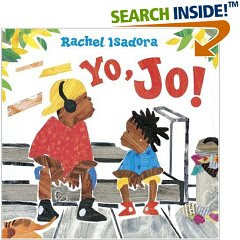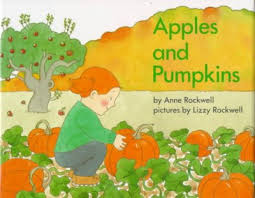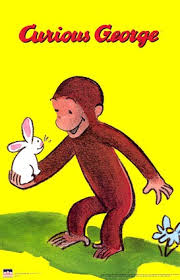
Isadora, Rachel. Yo, Jo. New York: Hardcourt Books, 2007. Print.
Jomar greets his neighbors using slang, but his grandfather wants to hear some more traditional words.
This picture book first captured my attention because of the unique title, after reading it I was split with two different reactions. I was astounded by the use of slang and improper grammatical language compared to most picture books, children that read these books are oftentimes not old enough to realize the book is written with slang and these words should not be used in the classroom. So my thinking is why do we have a book in the classroom that is teaching our children improper grammar when proper grammar is becoming harder and harder to find in the primary and secondary classroom? This was somewhat astounding to me; however, I was struck with another reaction that the grandpa was asking the child to use different words, more traditional words, but in the book this did not happen until the very last page and would not be very noticeable for a child. The main character of the book was obviously black but some of the other characters in the book that were also using slang words were white, including a little boy and girl so I do not believe the book was trying to suggest that only a certain race uses slang words. Perhaps some little children would enjoy this book because of the wonderful, unique illustrations that were quite unusual compared to most other books, but I would not read it to my own children or students in my classroom. If educators are suppose to set good examples for our children and select books that teach proper grammar (especially to the elementary school) this book would not be a good selection.

Ehlert, Louis. Color Zoo. Singapore: Harper Collins Publishers, 1989. Print.
This book only has a few lines of text: Shapes and colors in your zoo, lots of things that you can do, heads and ears, beaks, and snouts, that's what animals are all about. I know animals and you do too; make some new ones for your zoo.
I really enjoyed this book because it provides a great opportunity for younger children (probably preschool, kindergarten, or first graders) to not only learn their shapes but to have a fun educational day in the classroom. This book has a very basic but creative idea, each page contained a different animal made out of a geometric shape and as you turned each page the shape changed along with the type of animal. So for example, a tiger made out of a rectangle would be a square made out of a mouse when you turn the page. If you turn the page again, you would have a fox made out of a circle and a hexagon making a lion. So you have your basic shapes (like a square, triangle, circle) for the real little kids and more advanced shapes (like a hexagon, octagon, and diamond) for the older children. The real reason why I enjoyed this book was it gave me a very fun and inventive game I could make for my children in the classroom, especially for the real young ones. After reading and showing the book to my students, I could ask each of them to get out all of their art supplies and create masks (out of geometric shapes) of their favorite animals, it would help the kids with math, art, and animal sounds, plus it would be an activity that would not only be educational but it would be a lot of fun. Then each child could share their creation with the rest of the class and they could even be used in a little class play or something in their art class.
Rockwell, Anne. Can I Help? New York: Macmillan Publishing Company, 1982. Print.
A little girl asks to do some chores around the house, some of them she is old enough to help with but others are too dangerous for such a young girl. At the end of the book, her parents help with her chores.
I found this book to be rather interesting for a few reasons, first I thought it was interesting that a picture book (which are usually meant for children) had a very overt message: help with your chores, ask your parents if they need help with their chores, and ask them if they will help with your chores; I just thought it was funny how most of these older picture books are trying to teach our children to do something, compared to "new age" picture books like Yo, Jo which really have no purpose and might be teaching our children to use slang, I'm not really sure. I think its beneficial to not only entertain our children with picture books but to also teach them how to do something or why to do something. In this book, the children are taught that it is polite to put things away after you get them out, to ask your parents if they need help around the house, and to know that when you help your parents (or someone else) out with something the debt will usually be re-paid one way or another. Another aspect of the book that I found interesting was the gender of the child, female, I am not really sure if this was intended to be this way or not but the book is kind of an older one, 1982. I realize this is way after women began working out of the house but it is kind of funny that most of the chores were inside and that women in the past have been typically associated with inside tasks, perhaps just an accident? Probably.

Rockwell, Anne. Apples and Pumpkins. New York: Macmillan Publishing Company, 1989. Print.
During the fall, a family goes to pick pumpkins and apples. They look for the best ones, then father carves out a face and makes a jack-o-lantern. The children then dress up in their costumes and go trick-or-treating.
I thought this would be a very fun book during the Halloween season or simply during anytime in the month of October. This book would be fun to read to maybe third, fourth, or even fifth graders and assign them with a few activities after they are done reading it. One idea was that (with the teachers help) the students could make a jack-o-lantern with a candle inside it and place it inside the classroom for the rest of the students in the school to view. This would be not only fun for the students but a fun time for the teacher, something different than just watching a movie the day before Halloween or simply cutting out some Halloween decorations. Another task you could have the children do is to tell them to dress up in their favorite Halloween costumes before reading the book to the class and put on a play for another class or perhaps the entire school, anything fun for the students the day before or a couple days before Halloween, anything to let them get a little energy out of their system, they could even do the play at lunch time or recess. Perhaps the teacher could ask the children to find the very best looking pumpkin or the shiniest apple and reward the best one with some candy, a little extra time for recess, or some extra credit on a tough quiz or test. These would be fun activities associated with the book and a good way to do something both fun and unique during the Halloween season.

Rey, H.A. Curious George. Boston: Houghton Mifflin Company, 1969. Print.
A monkey is captured in Africa because he acted too curious, he is later brought to America. He fakes a 911 call and is sent to jail; however, he escapes flies over the city and eventually finds a home at the zoo.
I greatly enjoyed these series of picture books growing up and I think it's important to never forget to share them with not only our own children but also our classroom of kids. The series usually has a little moral to it (like curiosity got George in trouble, or in other words: curiosity killed the cat) but mostly they're just fun reads with great pictures and a cute, fun little story. For an assignment, the teacher could ask the children to read another book in the series or a specific one in the series to really get the children into the collection. These books could really be good for any child in the primary classroom, from the more advanced first grader to the reading-hating fifth grader. This book is in its 29th printing and I think it reminds the reader (or should remind the reader) that a great book no matter what the difficulty is will forever be a classic and will never go out of style. For a fun activity after reading the book with the classroom you could ask your kids a time when their curiosity got them into trouble and what they would have done differently if given a second chance. A teacher could even share a time in their life when they got a little too curious and it got them into trouble. There are many different things you could do with this book and I think that is why a true classic never goes out of print.




No comments:
Post a Comment